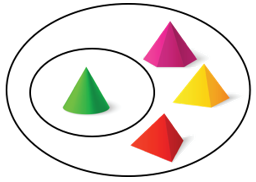Purpose
The purpose of this activity is to support students classifying three-dimensional shapes by their properties. In mathematics, shape names refer to all the possible shapes that are possible when meeting a defined set of properties.
Achievement Objectives
GM3-3: Classify plane shapes and prisms by their spatial features.
Required Resource Materials
- Copymaster or a set of 3D shape blocks
- Loops of rope, twine, or fabric
- Cards to label the diagrams (File card size)
- Marker pen
Activity
- Use a large, empty space (e.g. the floor) and loops of rope or another material to make the following Venn diagram. This activity could also be carried out using digital tools.
I made these spaces to show that whatever shapes are in here (trace around small oval) also belong in here (trace around large oval).
- Place the cone, hexagonal pyramid, square pyramid, and triangular pyramid from the Copymaster in the Venn Diagram. All shapes except for the cone should be placed in the large hoop.
Talk to your partner about this diagram.
What is the same about all the shapes?
Why is the shape in the inner hoop special?
You might introduce the relevant te reo Māori kupu as you discuss these shapes koeko (cone, pyramid).
- After a suitable time gather the group to discuss their ideas. Look for students to make statements about the properties of all the shapes. Examples might be:
- All the shapes have an apex.
- All the shapes have triangular faces, except the cone.
- The shapes are all pyramids.
- Look up the definition of a pyramid using an online mathematics dictionary. The definition should be:
“A polyhedron of which one face is a polygon of any number of sides, and the other faces are triangles with a common vertex.”
Unpack the definition, including the meaning of polyhedron, polygon, and common vertex.
What is the shape in the smaller hoop? (A cone)
Is a cone a pyramid? Why or why not?
Students might decide that the cone does not meet the requirements of a pyramid since it has no triangular faces. It does have a common vertex, the apex.
- Use cards to name the rings in the Venn Diagram. Discuss what should be on each card, such as “3-dimensional shapes with an apex” and “cones”. On the back of each card write the defining properties.
Apex: A base that is a 2-dimensional shape, an apex (common vertex)
Cones: Circle base, an apex, a curved surface
Note: From a measurement perspective it is helpful to see a cone as a special type of pyramid since the volume formulas for cones and pyramids are related.
- Put all the shapes in the large, empty space.
Are any of these shapes related? Do some shapes have the same property?
Let students offer their ideas.
Common binary (two independent sets) sorts include:- Shapes with curved surfaces and shapes with only polygonal surfaces.
- Prisms and non-prisms
- Shapes with all faces identical and shapes with different faces
- For each method of sorting the shapes, discuss:
- How are the shapes sorted? Can we label the sets?
- What property is the same about all the shapes in each group?
- Use cards to label the sets and define the properties.
- Provide students with a copy of the Copymaster. Ask them to work in pairs to create a poster that sorts all the shapes. If some shapes do not belong, then they are place outside the set rings as “non-examples.”
Next steps
- Ask students to connect three-dimension shapes to purpose by search online for examples of how the shapes are used or occur in nature. For example, pyramids are usually associated with Egypt but also are used to the architecture of other cultures. Cones and cylinders are used in storage of grain. Cones form when grain, sawdust, or sand are poured from a single source. Mt Taranaki is nearly a perfect cone. The steps of the Devil’s Causeway in Ireland are hexagonal prisms.
How do the uses of three-dimensional shapes relate to their properties?
- Create the flat patterns (nets) that fold up to form three-dimensional shapes.
- Draw three-dimensional shapes or combinations of shapes from the front, side and top.
Can a classmate recognise the shapes from your drawings?
Attachments
three-dimensional-shapes.pdf696.07 KB
Add to plan
Level Three